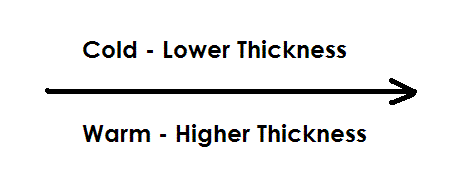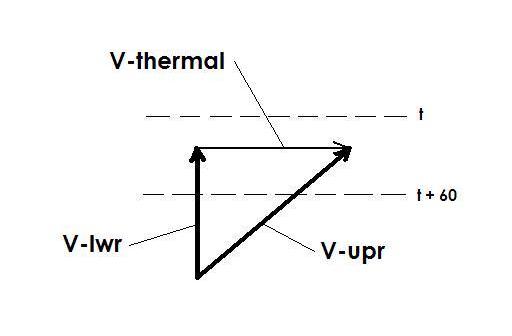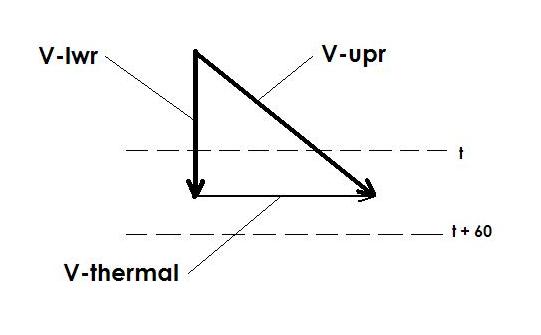 |
| Thermal Wind Relationship to Thickness (NH) |
Upon completion of this web page you will be able to:
Thermal wind is a theoretical concept that describes the wind shear between two levels in terms of the geostrophic wind at those two levels. The easiest way to visualize thermal wind or geostrophic wind shear is to use the vector relationship:
In dynamic meteorology courses you will derive the vector relationship between the thermal wind and thickness. For the purposes of this course, this relationship will be expressed in its scalar form as follows:
This equation says that the magnitude of the thermal wind for a given layer is proportional to the thickness gradient for that layer. In other words, the closer together the thickness contours, the stronger the thermal wind and hence the larger the vertical geostrophic wind shear. The farther apart the thickness contours, the weaker the thermal wind and hence the smaller the vertical geostrophic wind shear.
The vector form of the above equation says that the thermal wind vector is directed along the thickness contours with cold air on the left (looking downshear). Pictorially, where the black arrow represents the thermal wind vector:
 |
| Thermal Wind Relationship to Thickness (NH) |
In the Southern Hemisphere, the relationship is reversed with warm air on the left. Does this discussion remind you of the geostrophic wind relationship to height contours?
The thermal wind relationship can be used to assess the type of thermal advection that is occurring within the layer under consideration.
Consider the following situation:
 |
| Warm Air Advection and Veering Wind |
The lower and upper level geostrophic wind vectors are shown above with the wind direction turning clockwise or veering with increasing height. The thermal wind vector is shown as the wind shear vector between the two layers. Using the relationship of thickness to the thermal wind vector, there will be lower (colder) thickness to the top of the figure and higher (warmer) thickness values to the bottom of the figure.
Examination of the figure indicates that the lower and upper level geostrophic winds are blowing from warmer toward colder thickness values. In other words, there is warm air advection in the layer.
Compare the above situation to the following:
 |
| Cold Air Advection and Backing Wind |
The lower and upper level geostrophic wind vectors are shown above with the wind direction turning counter-clockwise or backing with increasing height. The thermal wind vector is again shown as the wind shear vector between the two layers. Using the relationship of thickness to the thermal wind vector, there will again be lower (colder) thickness to the top of the figure and higher (warmer) thickness values to the bottom of the figure.
Examination of the figure indicates that the lower and upper level geostrophic winds are blowing from colder toward warmer thickness values. In other words, there is cold air advection in the layer.
Summarizing these results:
| When the geostrophic winds turn clockwise or veer with height through a layer, warm air advection is occurring in the layer |
| When the geostrophic winds turn counter-clockwise or back with height through the layer, cold air advection is occurring in the layer |
Although the above discussion is based on theoretical relationships, it can be applied to vertical profiles of wind direction and speed. Essentially, examination of the change in wind direction with height implies the something about the thermal advection in the layer.
For example, if the winds veer with height through a layer, the implication is that warm air advection is occurring in the layer. Similarly, if the winds back with height through a layer, the implication is that cold air advection is occurring in the layer.
Similarly, the wind shear vector can imply something about the relative direction of warm and cold air for a particular layer.
The bottom line: if the only weather data you have are location surface observations and a local sounding, you can imply something about the regional thermal structure by applying the concept of thermal wind as discussed in this lesson. In the "old days" this process was known as single station analysis.
One way of evaluating backing and veering is the hodograph. A hodograph is a polar-coordinate presentation of wind speed and wind direction. See the web page on hodographs on the Operational Weather Topics page.
Instructions: Place the cursor over the answer of your choice. If you are correct, it will be highlighted in green; if you are incorrect, it will be highlighted in red.
Thermal wind is defined as:
In the Northern Hemisphere, lower thickness values are found:
Wind veering with height indicate:
If you were isolated and your only data were local surface observations and a local sounding, you could still analyze the local environment and make a short term forecast.